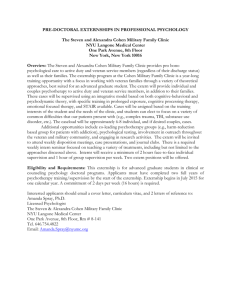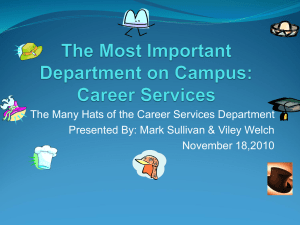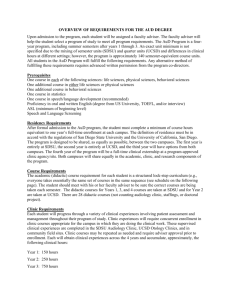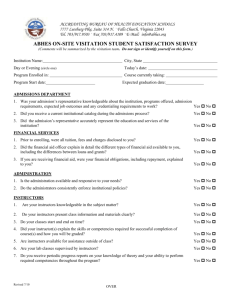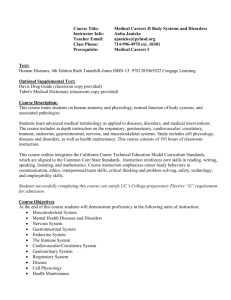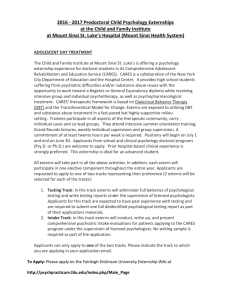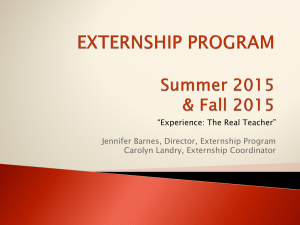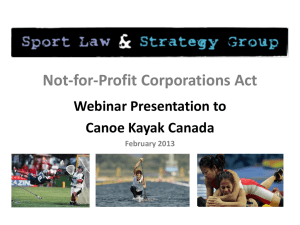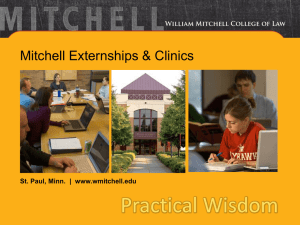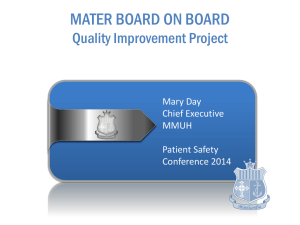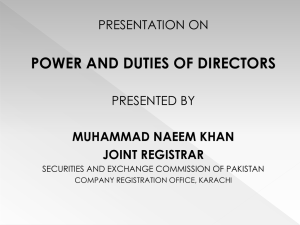Doctor of Audiology Program Director Survey
advertisement
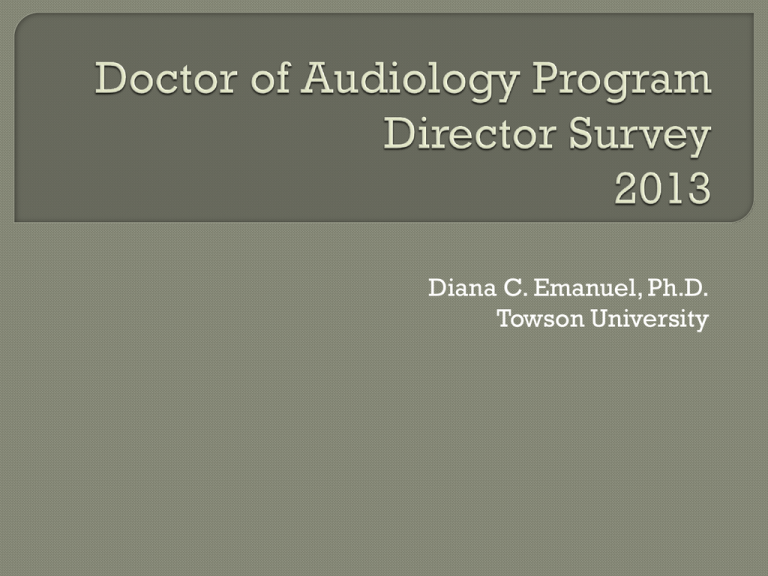
Diana C. Emanuel, Ph.D. Towson University Summary: Program directors were not informed and did not provide input on praxis changes but changes have impacted their programs. Positive comments: Efficient/streamlined Fewer recommendation letters to write Computes GPA Well organized n=8 Work in progress Slow Issues with data management n=4 Summary: Just over 1/3 are using CSDCAS and most of the comments are positive Large increase seen just in last 1-2 years n=5 Summary: Students are applying to more programs n=2 About ¾ of Au.D. programs reported recent growth in number of applicants Quality of students is improving n = 2 Students do not honor commitment to attend a program Summary: About 1/3 report increase in non-CSD applicants but only 1/5 are admitting more non-CSD applicants Recommend but not require additional courses n=3 Conditional admission n=1 Case by case examination n=1 We prefer non-CSD; AuD program contains all they need n=1 Summary: Programs vary widely in requirements for non-CSD students. CSD students no better or worse than non-CSD students n=5 CSD students need better STEM preparation n=5 Depends on the program n=3 Too much emphasis on SLP n =2 Wide variety in ability n=2 Summary: About ½ of the program directors think CSD students are prepared for an Au.D. program. Students should have STEM background Later offer of funding from other university n = 20 Personal/medical n = 14 Admitted from waitlist elsewhere n = 13 No problem with students withdrawing n=7 Chose closer/less expensive school n=2 Accepted multiple offers; chose later n =1 Summary: 2/3 of program directors lose students after they accept admission; Most frequency reason is late offer of funding from other school Not enough qualified applicants (too few Ph.D.s with research experience) n=4 Inadequate salary in academia n =1 Workload issues (too many classes across diverse subject areas) n =1 Summary: About ½ report moderate to great difficulty recruiting faculty; few listed reasons, but too few Ph.D. applicants was most common Summary: Most programs do not have difficulty retaining audiology faculty. Summary: The majority of Au.D. faculty are not eligible for tenure/tenure track positions/tenure; Most are eligible for promotion Clinical faculty/preceptors must hold CCC but research faculty do not n=7 Because we also have a speech program/required for accreditation n =2 We have discussed dropping the CCC requirement n=1 Required if participating in revenue sharing n=1 Paid by department n =1 “Nobody around here is interested in pulling the ladder up after themselves.” n =1 Summary: Just under ½ of Au.D. programs require faculty to hold the CCC-A Summary: Just over ½ of Au.D. programs require CCC-A for externship supervisors; about ½ have little difficulty finding these placements Comments: Students choice (n=12), needed for state licensure (n=1), needed for program accreditation (n=1). Summary: Waivers (n) Programs (n) 0 7 1-3 5 10-12 3 40 1 Just over 1/3 of programs have a 4th year CCC-A waiver; over ½ of these have an informed consent process; mean of 5 waivers reported per program with waiver process Summary: Just over ½ of directors feel the Au.D. should be a 4year program. Yes No 3-year program is just M.S. + CFY (n = 2) Programs should be competency based (n = 4) We need to get away from “minimum to get by” mentality (n = 1) It can be shorter and still good (n = 3) There should be an unsure box, not totally convinced of “yes” (n = 1) Economic factors (n = 2) 4th year externship is a bad model (n = 3) Other clinical doctorates (N.P.; P.A.) are 3-yr (n = 1) 10 years out we are still asking about length; some programs can’t deliver coursework and clinic; it’s embarrassing (n = 1) • 33 directors made comments: • Change to a 3- year program (n = 11) • • • • • • • • • Omit externship as part of degree (e.g., 1-yr residency) (n = 6) Undergraduate program in audiology (n = 1) Better connections between clinic/didactic/research (n=1) Economic sustainability for externship (n=1) Greater emphasis on STEM (n=1) Summary: More specialty certification (n=1) One accrediting body (CAA) (n=1) Most (80%) provided Minimize influence of industry (n=1) suggestions; 1/3 Licensure only for supervision (n=1) suggested separating externship from degree program Summary: Vast majority of programs use course, clinic, and programlevel assessment systems 9/11 (82%) of “other” indicated “forms” Summary: Most programs are tracking with spreadsheets or forms Summary: Programs are using surveys extensively to examine the efficacy of clinical assessment “other” = interview (n=2), site visit (n=1), “we review everything and ask everyone” (n=1) “other” = grand rounds (n=7), capstone presentation (n=6), comps (n=3), other presentation (n=3), counseling (n=1). Summary: Programs are using multiple formats for assessment of oral and written skills for Au.D. students “other” = clinic report writing (n=7), other project (n=4), comps (n=3). *Note: flaw in survey – directors could not move ahead without answering the question *Summary: Comments: • Department not university requirement (n=4) • Delay is due to student not program (n=3) • Time consuming (n=2) • Clinic limits size more than project (n=2) • Very important part of the program (n=2) Thesis-type projects are required by ½ of programs; this limits program size for 1/3 of programs and delays graduation for students in 1/5 of programs. Clinical grand rounds student presentations (or simulated cases) on a weekly basis is critical for binding the didactic and clinical learning Both oral and written assessments are necessary due to the nature of the AuD program Assessment has not (yet) yielded insights that have resulted in improvements commensurate with the time investment. At the end of each semester, clinical and academic faculty meet and discuss every student's progress in skills, knowledge, and professionalism. A report summarizing the discussion is provided to each student and placed in their file. Build ongoing and user friendly assessment tools. Actively analyze and use the data that you collect as part of the ongoing assessment. Engage the faculty, staff and students in the ongoing assessment processes that are used. Collect useful data - that is something of interest/concern you can actually act on once you have the information; do not be afraid to institute remediation plans; should include combination of objective (e.g. activity/hours) and subjective (ratings) measures assessment guidelines for research projects established/shared apriori Communication amongst faculty to insure appropriate training is essential. Don't admit weak students Hold frequent meetings with each cohort of students to facilitate their progress through the program Don't be afraid to critically assess the existing program. We must develop 21st century methods of training audiologists. We are still using many of the same models from the mid-late 20th century!! Find what works for your program and don't assume what other programs use is what is best for your students. Have specific written expectations for student skill levels as they progress through the program. Have a consistent clinical rotation for students in the first two years so that external supervisors know what level of skills to expect from students. Have a 'sheltered' environment that students can stay in or return to if their skill level does not advance as required. If you are going to be accredited by CAA be sure you have a paper trail. Do not accept below par students. You will pay for it time wise in the long run (or else they will drop out and your Dean will not be happy!) Make sure all faculty on board with participation in grading/creating the assessments, i.e., adjustment may have to be made in length/format of assessment -set clear guidelines/timelines to students on steps taken if assessment not met adequately Our summative oral assessment includes the presentation of prepared case studies to the student to discuss and assess before our entire faculty. This model has worked well for us. Provide practice and emphasis on the PRAXIS, since it is central to getting licensed, and difficult to prepare students for. Provide opportunities for all students in the first three years to meet weekly in an interactive seminar to build relationships and comradre (spell that), provide good one on one mentoring between student and a faculty, develop a strong student run SAA etc. etc. etc. The future of audiology education will not be found in the models of past audiology education. As long as audiology education is housed in CSD programs and under SLP leadership and dominance, audiology programs will not advance to the autonomy needed to support the new profession. New AuD program directors: sever your AuD program from CSD and be independent and function autonomously! Use interviews as part of admissions We are still learning. We assess students at the end of each year of the program using written and practical exams we have developed ourselves. The development of those exams (to assess the most important concepts of each year) resulted in major changes to our curriculum and was an important process for us. The administration of the exams every year serves as an important diagnostic tool for the students and for the program. We don't all need to be clones of each other, but there are some areas that need to be standardized. We have done a good job of transitioning to the AuD degree but we're not finished. We should not become complacent; rather, there is still a lot of work we need to do with our educational model. Education needs to be placed highly on the priority list of our national organizations and we all need to work together (individually and as organizations) to continue moving forward. We have put into place an on-site interview since the past five years as part of the admissions process. We have since then been able to enroll a higher caliber of students, increased our class sizes by about 40%, have almost a 100 retention rate (lost one student last fall-first time in five years),and had almost all students who accept come to our program. Also, having a dedicated faculty to deal with off-campus placements as well as fourth-year placements has been extremely beneficial. We did not require students from non-SHS majors to take any leveling courses and instead had a "boot camp" for a week before class where they crammed all the information. That did not work. Since the past 6 years we do require leveling courses and we probably lose some students but the students that do enter the program are better prepared, more motivated, and more likely to complete the program. Work on competency based assessments. You have to look at your entire Au.D. program and select the assessment tools that fit that program. You'll learn--don't worry. Summary: Great suggestions for new program directors; these will be posted Summary: Vast majority of programs have dedicated externship placement person Percentage of students receiving comp. Number (%) of programs 0-25% 2 (5%) 26-50% 5 (12%) 51-75% 6 (15%) 76-100% 28 (68%) Type of comp. Number (%) of programs Stipend 41 (100%) Traineeship 30 (73%) Salary 25 (61%) Fellowship/scholarship 13 (32%) Tuition remission 4 (10%) Commission 1 (2%) Summary: The majority of students receive compensation; most frequent compensation types are: stipend, traineeship, salary Summary: Mid-program M.S. Clinical site requirement It is wrong “should be abolished” (n=5) “Relic”/bad idea/not legal/ethical issue (n=19) Not intended for Au.D. students (n=3) Clinic has to look out for its own interests (n=2) Because of a site requirement (n=2) University policy (n=1) Just over 1/10th of programs award a master’s degree but 1/3 have tried to place students at sites that require it. Directors would like to see it abolished SLP coursework is missing (n=2); students need more pediatric hours (n=1) Percentage of students Number (%) of programs 0-25% 21 (54%) 26-50% 3 (8%) 51-75% 2 (5%) 76-100% 13 (33%) Summary: Temporary licensure is commonly required for externship; it is usually easy for Au.D. students to obtain Summary: About ½ strongly agree CAuDP should focus on issues with masters required for externship; only 1/5 felt strongly about the workforce study
